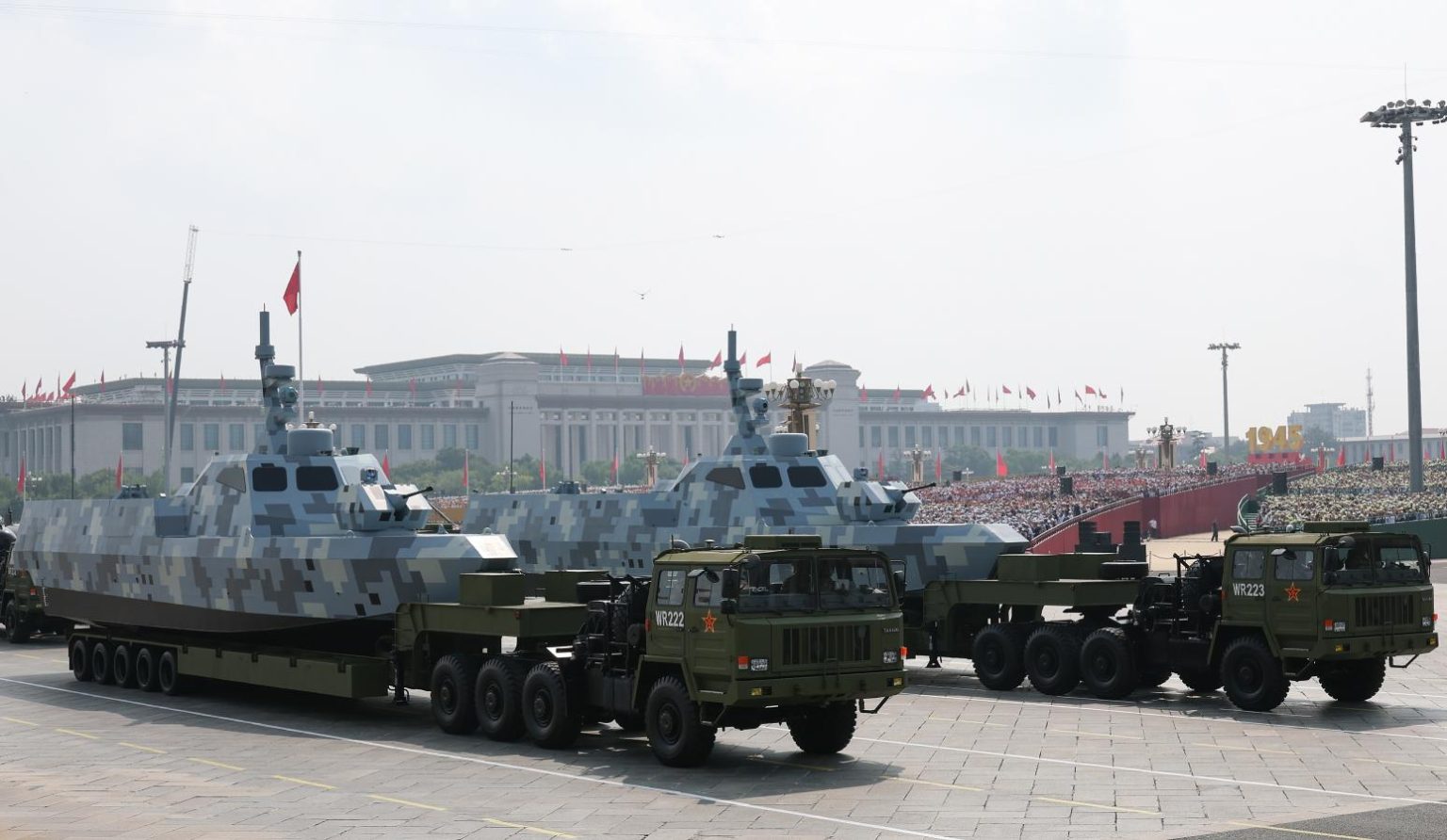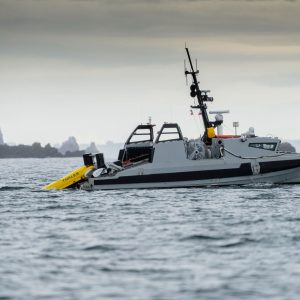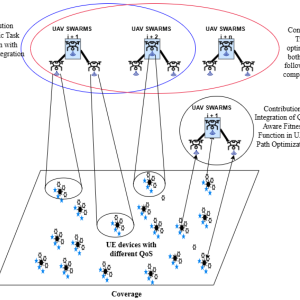China unmanned surface vessels took center stage at Beijing’s Victory Day parade, a highly choreographed reveal that framed autonomous maritime combat as a core element of the People’s Liberation Army Navy’s future order of battle.[1] The display, widely amplified by state media, underscored Beijing’s intent to normalize robotic platforms in contested waters and to bind them into a network‑centric web of sensors and shooters.[2][3]
Key Facts
- New USVs highlighted roles in covert deployment, blockade enforcement, autonomous detection/identification, and networked swarm attacks.[1]
- Chinese outlets indicated sea trials are complete; early operational integration is implied by public debut.[1][2]
- Swarm coordination aligns with Beijing’s broader military‑AI push and maritime sensing networks.[3][7]
- Debut coincides with parallel reveals of UUVs and hypersonic/cruise missiles, signaling multi‑domain integration.[2][4]
Why the debut matters for maritime denial
At face value, the parade validates years of investment in autonomous systems for sea control and sea denial. The presentation of China unmanned surface vessels alongside manned combatants conveys a doctrinal intent: USVs will not be niche science projects but routine contributors to layered maritime operations.[2] In practical terms, these boats can extend sensor reach, create ambiguity for opposing commanders, and offer a cost‑imposing tool to saturate defenses without risking crews.
Beijing’s media framing emphasized “covert deployment and blockade,” functions that map directly onto the geographies where China seeks persistent leverage—from the South China Sea’s crowded littorals to key straits around Taiwan. In these narrow seas, small radar cross‑sections, low acoustic signatures, and prolonged loiter enable USVs to act as unattended pickets or as first‑wave strikers if distributed in numbers. The central thesis is simple: mass, when networked, becomes a weapon of decision.
Capabilities signaled—and gaps not disclosed
The parade, by design, reveals posture rather than full performance parameters. Still, several attributes can be inferred from public cues and China’s recent unmanned R&D trajectory. First, autonomy and navigation logic will likely emphasize collaborative behaviors—target handoff, deconfliction, and dynamic re‑tasking—consistent with the “swarm” language reported by Chinese outlets.[1][2] Second, integration with broader maritime ISR meshes with evidence of a growing ocean‑surveillance backbone (e.g., the “Blue Ocean Information Network”) designed to fuse data from unmanned platforms and fixed seabed systems.[7]
Notably absent were hard details on displacement, propulsion, datalinks, or weapons fits. This is unsurprising. China typically withholds granular specifications during first public outings. Even so, the visual confirmation of an unmanned surface hull in a national parade—alongside the separate appearance of extra‑large UUVs—signals confidence that core subsystems have cleared basic maturity gates.[4][5]
Operational use cases: from pickets to saturation strikes
In a reconnaissance role, China unmanned surface vessels could act as forward tripwires, cuing shore‑based missiles or larger combatants. For blockade and area denial, swarms could seed approaches to straits, anchorages, or amphibious objective areas, forcing adversaries to waste interceptors and bandwidth on inexpensive targets. Ukraine’s campaign with explosive USVs—though operationally distinct—already illustrates how low‑signature craft can stress traditional defenses and reshape fleet risk calculus.[8]
In strike roles, modular payload bays open pathways from loitering munitions to lightweight ASCMs or non‑kinetic effects (EW, decoys). The center of gravity is software. If onboard autonomy handles basic navigation and collision avoidance, higher‑level coordination can ride on resilient comms (HF, SATCOM, line‑of‑sight mesh), enabling “many‑on‑few” tactics that magnify the value of each boat. This is where swarm logic threatens to break OODA loops: simultaneous multi‑axis attacks compress defender decision time beyond human bandwidth.
Strategic context: industry capacity and civil–military fusion
The USV debut sits within a broader surge in Chinese shipbuilding and naval modernization. Commercial‑military coupling gives Beijing scale advantages—rapid prototyping, plentiful hull production capacity, and a workforce that can pivot between civilian and defense orders. Analyses of China’s shipbuilding ecosystem underscore how this capacity translates into wartime resilience and the ability to absorb losses while sustaining operations.[9][10][11] When matched with maturing autonomy and AI workflows, quantity can achieve its own quality.
That said, parade optics are not combat proof. Validating contested‑environment performance—GPS‑denied navigation, emissions control, secure datalinks under jamming, target discrimination in clutter—remains a non‑trivial engineering task for any navy. Independent reporting cautions against over‑reading spectacles while acknowledging that each reveal shortens the timeline between concept and fielded capability.[2]
Implications for NATO and regional navies
For NATO and Indo‑Pacific partners, the emergence of swarm‑ready China unmanned surface vessels accelerates several imperatives: hardening of port and anchorage defenses; layered counter‑USV sensing (HF radar, passive acoustics, EO/IR) hooked to rapid‑effectors; and doctrinal updates that treat massed, autonomous surface craft as a baseline threat, not an edge case. Investing in defensive swarming and autonomous counter‑measures—fast interceptors, programmable fuses, and AI‑assisted engagement management—will be central to restoring cost‑exchange ratios in the defender’s favor.[12][13]
Technical insight: USV swarms shift the defender’s optimization problem from platform‑on‑platform matchups to compute‑on‑compute contests. Winning becomes less about bigger hulls and more about faster perception, resilient comms, and smart munitions.
Related on Defence Agenda
For a complementary look at Beijing’s multi‑domain reveal, see our coverage of China’s shipborne unmanned helicopters, which foreshadowed the pairing of aerial and surface drones in naval strike complexes: China shows naval unmanned helicopters.
External context
For verified details and imagery from the parade, review reporting and visuals from reputable outlets, including Reuters and Defense News, as well as analytical context from The Diplomat and pre‑parade assessments by Naval News.[2][3][4][5]
Further Reading
- Reuters: China’s war technology on parade
- Defense News: Unmanned systems featured prominently
- The Diplomat: Weapons on display at the parade
- Naval News: Anticipating unmanned undersea reveals
- RAND: The age of uncrewed surface vessels
References
- Defence Blog, “China displays new unmanned warships,” Sep 3, 2025. Link
- Reuters interactive, “China’s war technology on parade,” Sep 3, 2025. Link
- Defense News, “Xi, Putin, Kim Jong Un unite at glitzy China military parade,” Sep 3, 2025. Link
- The Diplomat, “What Were the Weapons on Display in China’s Military Parade?,” Sep 3, 2025. Link
- Naval News, “What the World Is About to Learn about China’s XLUUVs,” Aug 16, 2025. Link
- Global Times, “Unmanned ship is reviewed at China’s V‑Day parade,” Sep 3, 2025. Link
- CSIS AMTI, “Exploring China’s Unmanned Ocean Network,” Jun 16, 2020. Link
- RAND, “The Age of Uncrewed Surface Vessels,” Nov 15, 2022. Link
- CSIS, “Ship Wars: Confronting China’s Dual‑Use Shipbuilding Empire,” Mar 11, 2025. Link
- CSIS, “Unpacking China’s Naval Buildup,” Jun 5, 2024. Link
- CRS, “China Naval Modernization: Implications for U.S. Navy,” Jun 14, 2024. Link
- Hybrid CoE Working Paper 34, “Uncrewed maritime vessels,” Oct 7, 2024. Link











